Conference Presentations by Yen-I Lee
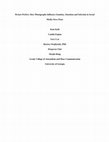
Social media have been the primary conduit to news access for an increasing number of consumers, ... more Social media have been the primary conduit to news access for an increasing number of consumers, yet little is known about how consumers view social media posts containing news, and on what basis they make decisions about selecting and sharing this information. In a within-subjects eye-tracking experiment, this study examined the influence of image presence and valence on attention to and engagement with news stories on social media. Participants (N=60) viewed a series of 29 social media posts of news stories, each of which was either paired with no image, a positively valenced image, or a negatively valenced image, while their attention to images was recorded with an eye-tracking device, and subsequently completed several dependent measures about each image viewed. The results show that posts containing positive images elicited a higher level of emotion than those with negative or neutral images, which led to higher intentions to click and share posts with positive images. The results provide a deeper understanding of how social media drive news consumption, and offer practical implications for journalists, news organizations and groups using social media to spread a message.
Papers by Yen-I Lee
JOURNAL OF INTERNATIONAL CRISIS AND RISK COMMUNICATION RESEARCH, 2019
This study first refines the conceptual framework of publics’ communicative behavior in social-me... more This study first refines the conceptual framework of publics’ communicative behavior in social-mediated health crises. Then two multiple-item scales for measuring publics’ health crisis information
seeking and sharing (CISS) are developed and tested by employing online survey data sets from a random national sample of 279 adults and 280 adults in the United States, respectively. Results indicate seven types of crisis information seeking behavior and 17 types of crisis information sharing behavior crossing over platforms, channels, and information sources. The CISS scales provide a valid and reliable tool for crisis communication researchers and practitioners to measure publics’
information seeking and sharing activities in social-mediated public health crisis communication.
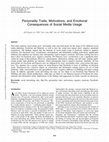
This study explores social media users' personality traits and motivations for the usage of two d... more This study explores social media users' personality traits and motivations for the usage of two different social media platforms, Facebook and Pinterest, as well as how the varied uses impact users' negative emotional experiences. The findings suggest that the intensity of social media usage is positively related to negative emotions. For Facebook users, socialization, entertainment, and information seeking motivations significantly influence their platform use intensity and, subsequently, lead to negative emotions. Self-status seeking also has a direct effect on Facebook users' negative emotions. For Pinterest users, socialization is not a significant motivation for usage of that platform. However, entertainment, information seeking, and self-status seeking significantly predict their platform use intensity, which subsequently lead to negative emotions. Similarly, all four motivations for Facebook and Pinterest uses are influenced by users' personality traits: extraversion and openness. Yet, openness has a greater impact on using Pinterest than Facebook in terms of fulfilling socialization needs. Neuroticism has a positive impact on socialization and information seeking motives for use of both platforms, while conscientiousness and agreeableness have a negative influence on fulfilling self-status seeking needs. In addition, agreeable social networking site users are less likely to use Facebook than Pinterest for fulfilling self-status related gratifications, while they are likely to use Pinterest instead of Facebook for entertainment and information needs. Implications of the findings and suggestions for future research are discussed.

Social Marketing Quarterly, 2018
A common challenge facing public health practitioners and social marketers is how best to frame a... more A common challenge facing public health practitioners and social marketers is how best to frame and present benefit–risk information in campaigns that aim to change perceptions and increase acceptance of health recommendations, such as vaccinations. Given that public service advertisements and brand promises are often core components of social marketing and health communication efforts, this study examined whether, and how, framing and the use of text or image support to convey influenza vaccination brand promises affected college-attending young adults' beliefs and intentions regarding influenza vaccination. PSAs that varied with respect to gain or loss frame and type of support provided (i.e., image vs. text-supported) were used as the stimulus material. The findings indicated two pairings performed equally well with respect to the outcome measures used. A gain-framed image-supported PSA and a loss-framed text-supported PSA were both associated with the highest levels of positive affect toward the PSA, positive attitude toward flu vaccination, flu vaccination confidence, and flu vaccination intention. Overall, the findings highlight the importance of assessing both the framing used in social marketing or health communication materials and the approach used to support the framing. It is likely that the effectiveness of framing is affected by the visuals and text used to reinforce the brand promise conveyed by the framing, irrespective of whether it is positive or negative.
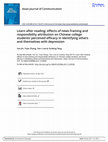
Depression is now one of the most severe public health threats in
China and among Chinese college... more Depression is now one of the most severe public health threats in
China and among Chinese college students. To examine the effects of depression news coverage on Chinese college students’ mental health literacy, focusing on their perceived efficacy in recognizing depression symptoms, a 2 (news framing: episodic vs. thematic) × 2 (responsibility attribution: individual vs. societal) × 2 (gender: female vs. male) between-subjects experiment was conducted among 187 students at a large research university in China. The key findings, after controlling for depression issue involvement, include: (1) the main effects of attribution on perceived efficacy in identifying others (friends and family members) with depression; (2) the association between gender and perceived efficacy in identifying family members with depression; and (3) the three-way interactions on how framing, attribution, and gender jointly affect not only perceived efficacy in identifying others but also themselves with depression. These findings provide insights on how depression news coverage can help enhance mental health literacy and build stronger
depression symptom resilience among Chinese college students. Implications for health journalists and public health communication professionals in China are discussed.
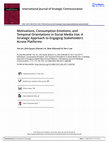
How to engage stakeholders effectively with different social media platforms is an important topi... more How to engage stakeholders effectively with different social media platforms is an important topic in strategic communication research. Grounded in uses and gratifications theory, consumption emotion theory, and temporal orientation framework, this study conducted an online survey among social media users in the United States (N = 940) to examine how individuals’ motivations, emotions, and temporal orientations in social media use might differ by multi-platform usage groups (i.e., Facebook+Instagram users vs. Facebook+Pinterset users). Our findings indicate that Facebook +Instagram users focus more on self-status seeking and entertainment, while Facebook+Pinterest users are more information-seeking driven and future-oriented. In addition, more optimism is detected among Facebook+Pinterest users. Implications for strategic communication theory development as well as insights for organization-stakeholder engagement on social
media are discussed.
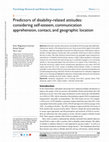
Individuals’ attitudes about persons with disability (PwD) strongly affect differently-abled pers... more Individuals’ attitudes about persons with disability (PwD) strongly affect differently-abled persons’ quality of life and position in society. Some research offers support for the ability of systematic, supported, longitudinal contact between different groups of individuals to improve
attitudes. College campuses, in particular, offer a potentially useful arena in which to facilitate this type of contact. This study explored contextual factors (eg, geographic region, biological sex) and predictors of disability-related attitudes among a college student population to determine strategies for course-based intervention design (eg, as community-engaged or service-learning initiatives). Surveying participants from universities in two regions of the United States, we
found that self-esteem, audience-based communication apprehension, and contact with PwD explain more than 50% of the variance in disability-related attitudes. Further, we found that geographic location affects both self-esteem and audience-based communication apprehension (communicating/interacting with PwD). We discuss the implications for community engagement and/or service learning and highlight the importance of partnerships among relevant community
stakeholders, including university faculty, students, and staff.
When Do Viewers Share Viral Video Advertising? The Role of Brand Prominence and Brand Disclosure Timing
Drafts by Yen-I Lee
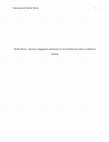
Mobile phones are the primary access point to the internet for many today, placing increased impo... more Mobile phones are the primary access point to the internet for many today, placing increased importance on how news organizations interact with the public on these devices. Images and text appear differently than they do on the desktop platform, and users’ processing of, perceptions of, and intention to engage with content may also vary as a consequence. To address these differences, this study delivered news images of various emotional valence via social media posts to users on a desktop or mobile devices, and used eye-tracking data and questionnaire measures to analyze how participants viewed and responded to the images. Results show that users pay significantly less attention to social media posts on mobile devices than on desktop, that posts that contain images were perceived as more arousing than posts with no image and that negative images were the most arousing. Implications for research and practitioners are discussed.









Uploads
Conference Presentations by Yen-I Lee
Papers by Yen-I Lee
seeking and sharing (CISS) are developed and tested by employing online survey data sets from a random national sample of 279 adults and 280 adults in the United States, respectively. Results indicate seven types of crisis information seeking behavior and 17 types of crisis information sharing behavior crossing over platforms, channels, and information sources. The CISS scales provide a valid and reliable tool for crisis communication researchers and practitioners to measure publics’
information seeking and sharing activities in social-mediated public health crisis communication.
China and among Chinese college students. To examine the effects of depression news coverage on Chinese college students’ mental health literacy, focusing on their perceived efficacy in recognizing depression symptoms, a 2 (news framing: episodic vs. thematic) × 2 (responsibility attribution: individual vs. societal) × 2 (gender: female vs. male) between-subjects experiment was conducted among 187 students at a large research university in China. The key findings, after controlling for depression issue involvement, include: (1) the main effects of attribution on perceived efficacy in identifying others (friends and family members) with depression; (2) the association between gender and perceived efficacy in identifying family members with depression; and (3) the three-way interactions on how framing, attribution, and gender jointly affect not only perceived efficacy in identifying others but also themselves with depression. These findings provide insights on how depression news coverage can help enhance mental health literacy and build stronger
depression symptom resilience among Chinese college students. Implications for health journalists and public health communication professionals in China are discussed.
media are discussed.
attitudes. College campuses, in particular, offer a potentially useful arena in which to facilitate this type of contact. This study explored contextual factors (eg, geographic region, biological sex) and predictors of disability-related attitudes among a college student population to determine strategies for course-based intervention design (eg, as community-engaged or service-learning initiatives). Surveying participants from universities in two regions of the United States, we
found that self-esteem, audience-based communication apprehension, and contact with PwD explain more than 50% of the variance in disability-related attitudes. Further, we found that geographic location affects both self-esteem and audience-based communication apprehension (communicating/interacting with PwD). We discuss the implications for community engagement and/or service learning and highlight the importance of partnerships among relevant community
stakeholders, including university faculty, students, and staff.
Drafts by Yen-I Lee
seeking and sharing (CISS) are developed and tested by employing online survey data sets from a random national sample of 279 adults and 280 adults in the United States, respectively. Results indicate seven types of crisis information seeking behavior and 17 types of crisis information sharing behavior crossing over platforms, channels, and information sources. The CISS scales provide a valid and reliable tool for crisis communication researchers and practitioners to measure publics’
information seeking and sharing activities in social-mediated public health crisis communication.
China and among Chinese college students. To examine the effects of depression news coverage on Chinese college students’ mental health literacy, focusing on their perceived efficacy in recognizing depression symptoms, a 2 (news framing: episodic vs. thematic) × 2 (responsibility attribution: individual vs. societal) × 2 (gender: female vs. male) between-subjects experiment was conducted among 187 students at a large research university in China. The key findings, after controlling for depression issue involvement, include: (1) the main effects of attribution on perceived efficacy in identifying others (friends and family members) with depression; (2) the association between gender and perceived efficacy in identifying family members with depression; and (3) the three-way interactions on how framing, attribution, and gender jointly affect not only perceived efficacy in identifying others but also themselves with depression. These findings provide insights on how depression news coverage can help enhance mental health literacy and build stronger
depression symptom resilience among Chinese college students. Implications for health journalists and public health communication professionals in China are discussed.
media are discussed.
attitudes. College campuses, in particular, offer a potentially useful arena in which to facilitate this type of contact. This study explored contextual factors (eg, geographic region, biological sex) and predictors of disability-related attitudes among a college student population to determine strategies for course-based intervention design (eg, as community-engaged or service-learning initiatives). Surveying participants from universities in two regions of the United States, we
found that self-esteem, audience-based communication apprehension, and contact with PwD explain more than 50% of the variance in disability-related attitudes. Further, we found that geographic location affects both self-esteem and audience-based communication apprehension (communicating/interacting with PwD). We discuss the implications for community engagement and/or service learning and highlight the importance of partnerships among relevant community
stakeholders, including university faculty, students, and staff.